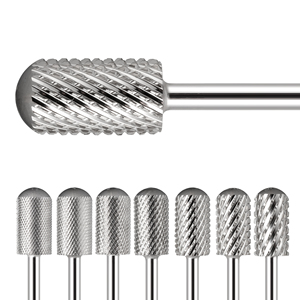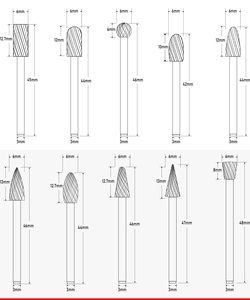
All categories
Featured selections
Trade Assurance
Buyer Central
Help Center
Get the app
Become a supplier

(1499 products available)





































high quality carbide die grinder bits are an essential component in the realm of industrial manufacturing, known for their exceptional hardness and durability. These materials are formed by combining fine particles of carbide with a metallic binder, typically cobalt. The result is a composite material that boasts remarkable wear resistance and toughness. high quality carbide die grinder bits are primarily used in cutting tools, wear parts, and other applications where high performance and longevity are required. Their ability to maintain sharp edges and resist deformation under high stress makes them invaluable in industries ranging from aerospace to mining and construction.
The variety of high quality carbide die grinder bits available caters to a broad spectrum of industrial applications. Common types include tungsten carbide and titanium carbide, each offering unique properties. Tungsten carbide is renowned for its extreme hardness and is frequently used in cutting tools such as drills and milling cutters. Titanium carbide, while slightly softer, provides excellent thermal resistance, making it ideal for high-temperature applications. Additionally, there are specialized high quality carbide die grinder bits designed for specific uses, such as corrosion-resistant grades for chemical processing or impact-resistant grades for mining operations. Each type is engineered to meet the demands of its intended application, ensuring optimal performance and durability.
high quality carbide die grinder bits are valued for their exceptional mechanical properties, which include high hardness, wear resistance, and toughness. These features enable them to perform effectively in harsh conditions, such as high temperatures and abrasive environments. high quality carbide die grinder bits maintain their cutting edge longer than traditional tool materials, reducing downtime and increasing productivity. The unique combination of hardness and toughness also allows them to withstand significant stress without fracturing. This makes them ideal for applications where precision and reliability are critical. Moreover, advancements in manufacturing techniques have led to the development of high quality carbide die grinder bits with enhanced properties, such as improved corrosion resistance and reduced brittleness.
The production of high quality carbide die grinder bits involves a meticulous process of combining carbide particles with a metallic binder. Tungsten carbide is the most commonly used carbide, while cobalt or nickel typically serves as the binder. The proportion of carbide to binder can vary depending on the desired properties of the final product. Additives such as tantalum carbide or niobium carbide may be included to enhance specific characteristics, such as toughness or heat resistance. The choice of materials directly impacts the performance of high quality carbide die grinder bits, allowing manufacturers to tailor them to specific industrial needs. As sustainability becomes a priority, research is ongoing to identify more environmentally friendly binders and production methods.
Using high quality carbide die grinder bits effectively requires understanding their capabilities and limitations. To maximize their lifespan and performance, select the appropriate type based on the specific application and operating conditions. Ensure that high quality carbide die grinder bits are used within their design parameters to prevent premature wear or damage. Regular maintenance, such as cleaning and sharpening, can extend their usability and enhance efficiency. In machining applications, proper cooling and lubrication are crucial to prevent overheating and maintain the integrity of the cutting edge. By adhering to these guidelines, industries can leverage the full potential of high quality carbide die grinder bits, achieving superior productivity and cost-efficiency.
When selecting high quality carbide die grinder bits, it's crucial to consider the specific requirements of your application. The hardness and toughness of the material are paramount, as these properties determine its suitability for different tasks. For instance, tungsten carbide offers unparalleled hardness, making it ideal for cutting tools, while titanium carbide is preferred for applications requiring thermal resistance. Additionally, the selection of the binder, typically cobalt or nickel, can affect the performance of high quality carbide die grinder bits. It's essential to match the material's properties with the operating conditions to ensure optimal performance and longevity.
Several factors can influence the performance of high quality carbide die grinder bits. The grain size of the carbide particles plays a significant role, with finer grains typically offering higher hardness and wear resistance. However, finer grains may also lead to increased brittleness, so a balance must be struck based on the application. The ratio of carbide to binder also impacts performance; higher carbide content generally enhances hardness, while increased binder content improves toughness. Understanding these factors allows for informed decisions when choosing high quality carbide die grinder bits for specific industrial tasks.
As sustainability becomes a priority in industrial manufacturing, the environmental impact of high quality carbide die grinder bits production is gaining attention. Traditional binders like cobalt can have negative environmental effects, prompting research into more sustainable alternatives. Recycling and reclaiming used carbide materials can reduce waste and minimize resource consumption. Manufacturers are exploring innovative production methods to lessen the environmental footprint of high quality carbide die grinder bits. By prioritizing sustainability, industries can contribute to a more eco-friendly manufacturing landscape.
high quality carbide die grinder bits are primarily used in industries where high wear resistance and durability are necessary. They are commonly employed in cutting tools, mining equipment, and wear-resistant parts for machinery. The material's ability to withstand harsh conditions makes it suitable for aerospace and automotive applications as well.
The binder in high quality carbide die grinder bits plays a crucial role in its overall performance. Cobalt is the most common binder, offering excellent toughness, but nickel is often used in applications requiring higher corrosion resistance. The choice of binder affects the material's ability to withstand stress and environmental factors, impacting its longevity and effectiveness.
Yes, high quality carbide die grinder bits can be recycled, which helps reduce waste and conserve resources. Recycling involves reclaiming the carbide particles and binder for reuse in new products. This process not only minimizes environmental impact but also offers cost savings for manufacturers by reducing the need for raw materials.
Advancements in high quality carbide die grinder bits technology are focused on enhancing properties such as hardness, toughness, and corrosion resistance. Innovations include the development of new binder materials and techniques to produce finer carbide grains. These improvements aim to extend the lifespan and performance of cemented carbide products in demanding applications.
Industries can ensure the sustainability of high quality carbide die grinder bits by adopting practices such as recycling and using environmentally friendly binders. Additionally, optimizing manufacturing processes to reduce waste and energy consumption contributes to sustainability. Collaborating with suppliers who prioritize eco-friendly production methods can further enhance the environmental responsibility of cemented carbide use.